Academic and Business Research: Determinants of Employee Turnover
VerifiedAdded on 2021/06/17
|6
|924
|476
Report
AI Summary
This report analyzes a business research study focusing on employee turnover and skill retention within organizations. The study identifies dependent variables such as employee turnover and skill retention, and independent variables including human resource management practices, market/organizational characteristics, high-performance work system practices (HPWSP), and training practices. The research aims to understand the determinants of employee turnover from an organizational perspective, distinguishing between turnover and skill retention, examining management philosophies, and evaluating turnover models for different skill-based worker categories. The report details the measurement of variables using ratio scales, statistical analysis, and correlations. It also suggests the inclusion of organizational culture as a significant variable affecting employee turnover and skill retention, with constructs such as individuals, processes, structure, and environment. The report concludes with a list of references.
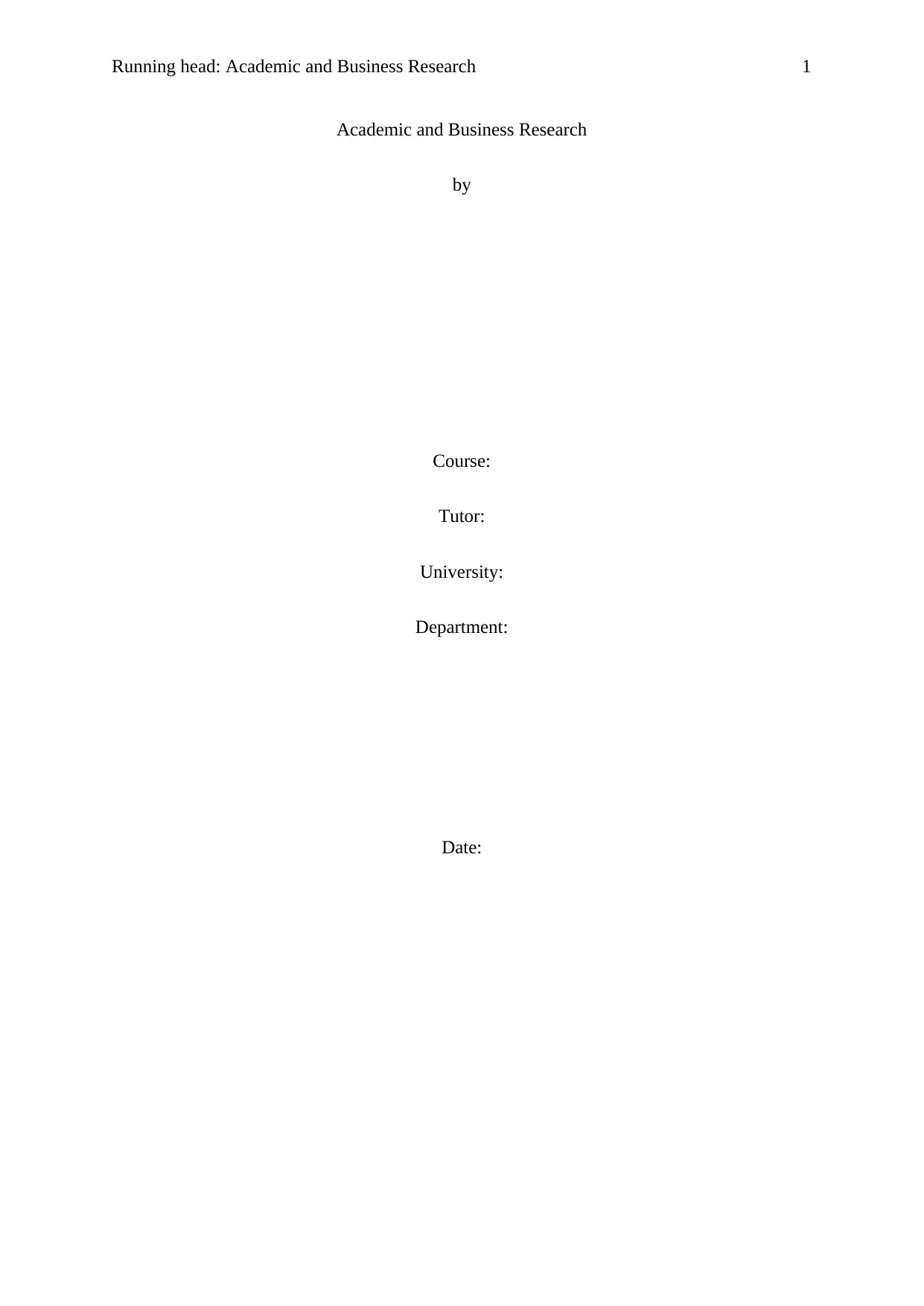
Running head: Academic and Business Research 1
Academic and Business Research
by
Course:
Tutor:
University:
Department:
Date:
Academic and Business Research
by
Course:
Tutor:
University:
Department:
Date:
Paraphrase This Document
Need a fresh take? Get an instant paraphrase of this document with our AI Paraphraser
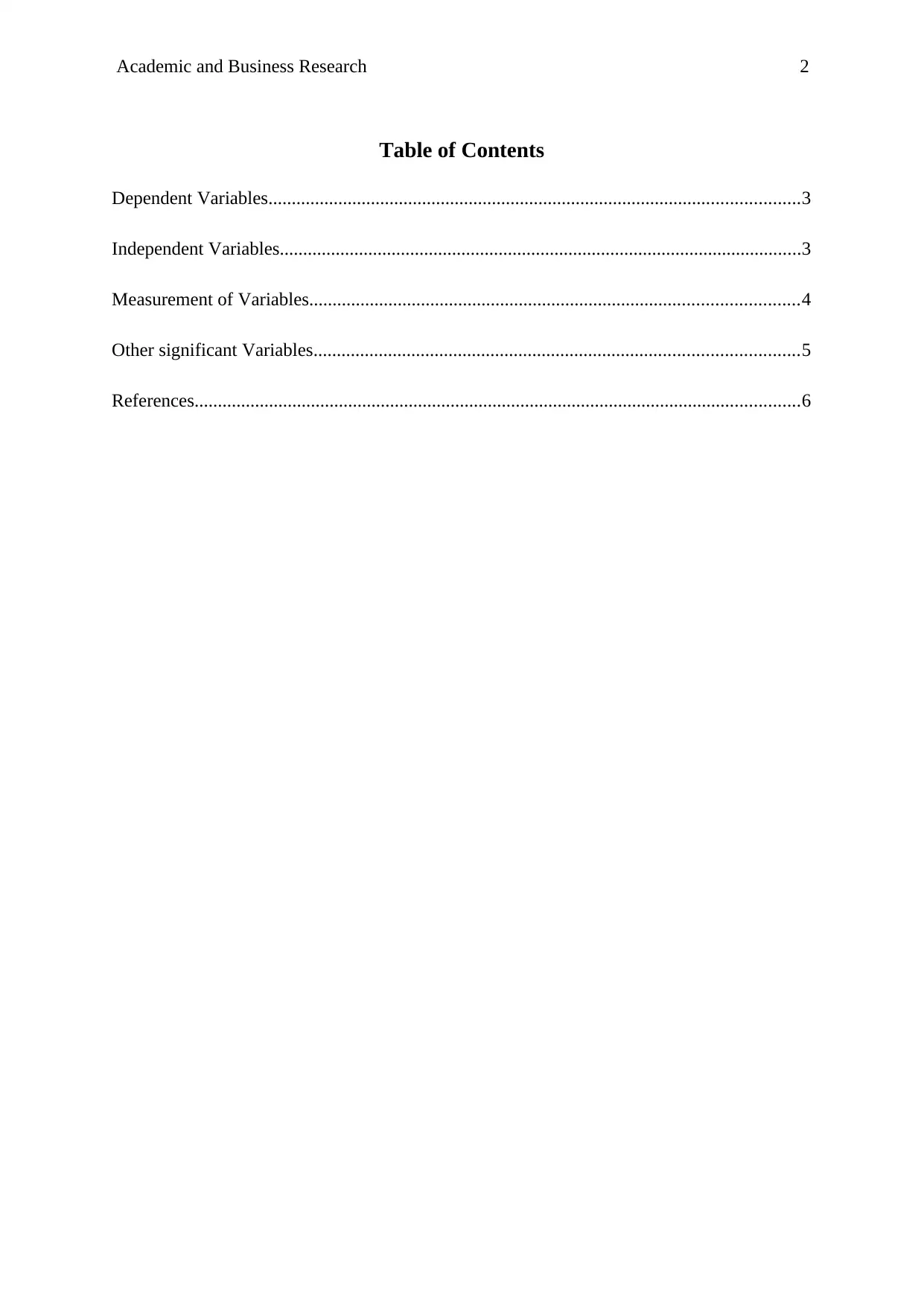
Academic and Business Research 2
Table of Contents
Dependent Variables..................................................................................................................3
Independent Variables................................................................................................................3
Measurement of Variables.........................................................................................................4
Other significant Variables........................................................................................................5
References..................................................................................................................................6
Table of Contents
Dependent Variables..................................................................................................................3
Independent Variables................................................................................................................3
Measurement of Variables.........................................................................................................4
Other significant Variables........................................................................................................5
References..................................................................................................................................6
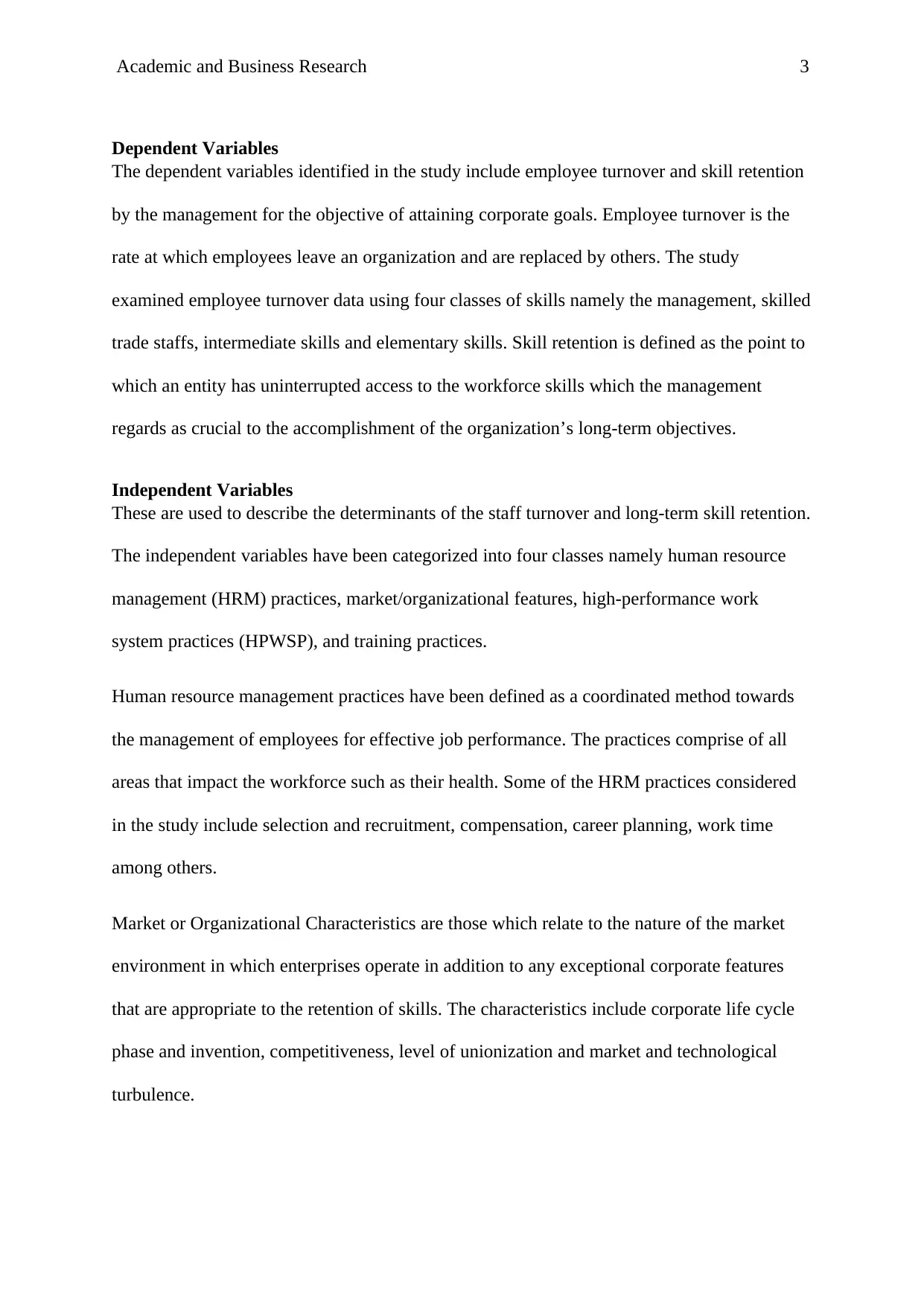
Academic and Business Research 3
Dependent Variables
The dependent variables identified in the study include employee turnover and skill retention
by the management for the objective of attaining corporate goals. Employee turnover is the
rate at which employees leave an organization and are replaced by others. The study
examined employee turnover data using four classes of skills namely the management, skilled
trade staffs, intermediate skills and elementary skills. Skill retention is defined as the point to
which an entity has uninterrupted access to the workforce skills which the management
regards as crucial to the accomplishment of the organization’s long-term objectives.
Independent Variables
These are used to describe the determinants of the staff turnover and long-term skill retention.
The independent variables have been categorized into four classes namely human resource
management (HRM) practices, market/organizational features, high-performance work
system practices (HPWSP), and training practices.
Human resource management practices have been defined as a coordinated method towards
the management of employees for effective job performance. The practices comprise of all
areas that impact the workforce such as their health. Some of the HRM practices considered
in the study include selection and recruitment, compensation, career planning, work time
among others.
Market or Organizational Characteristics are those which relate to the nature of the market
environment in which enterprises operate in addition to any exceptional corporate features
that are appropriate to the retention of skills. The characteristics include corporate life cycle
phase and invention, competitiveness, level of unionization and market and technological
turbulence.
Dependent Variables
The dependent variables identified in the study include employee turnover and skill retention
by the management for the objective of attaining corporate goals. Employee turnover is the
rate at which employees leave an organization and are replaced by others. The study
examined employee turnover data using four classes of skills namely the management, skilled
trade staffs, intermediate skills and elementary skills. Skill retention is defined as the point to
which an entity has uninterrupted access to the workforce skills which the management
regards as crucial to the accomplishment of the organization’s long-term objectives.
Independent Variables
These are used to describe the determinants of the staff turnover and long-term skill retention.
The independent variables have been categorized into four classes namely human resource
management (HRM) practices, market/organizational features, high-performance work
system practices (HPWSP), and training practices.
Human resource management practices have been defined as a coordinated method towards
the management of employees for effective job performance. The practices comprise of all
areas that impact the workforce such as their health. Some of the HRM practices considered
in the study include selection and recruitment, compensation, career planning, work time
among others.
Market or Organizational Characteristics are those which relate to the nature of the market
environment in which enterprises operate in addition to any exceptional corporate features
that are appropriate to the retention of skills. The characteristics include corporate life cycle
phase and invention, competitiveness, level of unionization and market and technological
turbulence.
⊘ This is a preview!⊘
Do you want full access?
Subscribe today to unlock all pages.

Trusted by 1+ million students worldwide
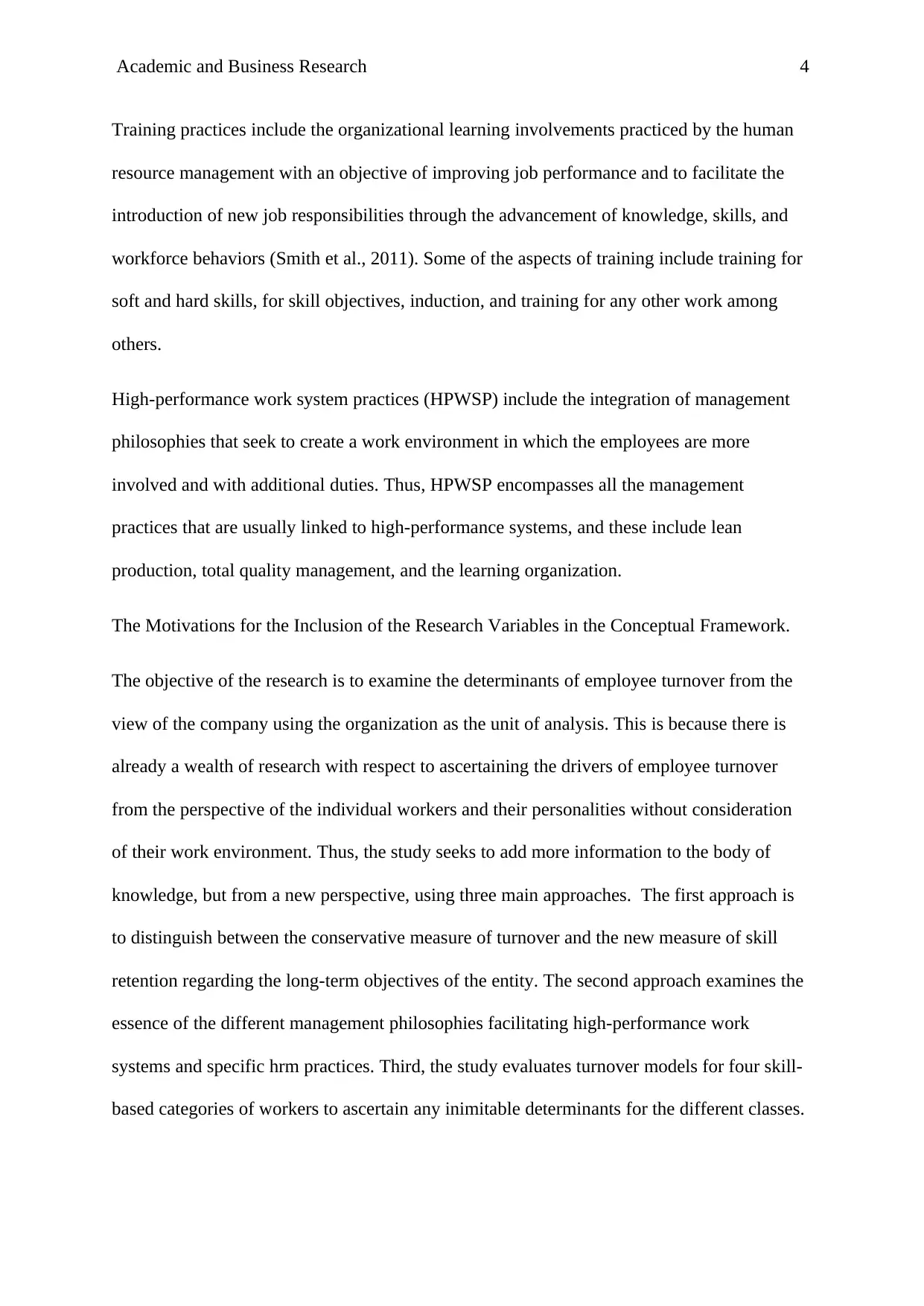
Academic and Business Research 4
Training practices include the organizational learning involvements practiced by the human
resource management with an objective of improving job performance and to facilitate the
introduction of new job responsibilities through the advancement of knowledge, skills, and
workforce behaviors (Smith et al., 2011). Some of the aspects of training include training for
soft and hard skills, for skill objectives, induction, and training for any other work among
others.
High-performance work system practices (HPWSP) include the integration of management
philosophies that seek to create a work environment in which the employees are more
involved and with additional duties. Thus, HPWSP encompasses all the management
practices that are usually linked to high-performance systems, and these include lean
production, total quality management, and the learning organization.
The Motivations for the Inclusion of the Research Variables in the Conceptual Framework.
The objective of the research is to examine the determinants of employee turnover from the
view of the company using the organization as the unit of analysis. This is because there is
already a wealth of research with respect to ascertaining the drivers of employee turnover
from the perspective of the individual workers and their personalities without consideration
of their work environment. Thus, the study seeks to add more information to the body of
knowledge, but from a new perspective, using three main approaches. The first approach is
to distinguish between the conservative measure of turnover and the new measure of skill
retention regarding the long-term objectives of the entity. The second approach examines the
essence of the different management philosophies facilitating high-performance work
systems and specific hrm practices. Third, the study evaluates turnover models for four skill-
based categories of workers to ascertain any inimitable determinants for the different classes.
Training practices include the organizational learning involvements practiced by the human
resource management with an objective of improving job performance and to facilitate the
introduction of new job responsibilities through the advancement of knowledge, skills, and
workforce behaviors (Smith et al., 2011). Some of the aspects of training include training for
soft and hard skills, for skill objectives, induction, and training for any other work among
others.
High-performance work system practices (HPWSP) include the integration of management
philosophies that seek to create a work environment in which the employees are more
involved and with additional duties. Thus, HPWSP encompasses all the management
practices that are usually linked to high-performance systems, and these include lean
production, total quality management, and the learning organization.
The Motivations for the Inclusion of the Research Variables in the Conceptual Framework.
The objective of the research is to examine the determinants of employee turnover from the
view of the company using the organization as the unit of analysis. This is because there is
already a wealth of research with respect to ascertaining the drivers of employee turnover
from the perspective of the individual workers and their personalities without consideration
of their work environment. Thus, the study seeks to add more information to the body of
knowledge, but from a new perspective, using three main approaches. The first approach is
to distinguish between the conservative measure of turnover and the new measure of skill
retention regarding the long-term objectives of the entity. The second approach examines the
essence of the different management philosophies facilitating high-performance work
systems and specific hrm practices. Third, the study evaluates turnover models for four skill-
based categories of workers to ascertain any inimitable determinants for the different classes.
Paraphrase This Document
Need a fresh take? Get an instant paraphrase of this document with our AI Paraphraser
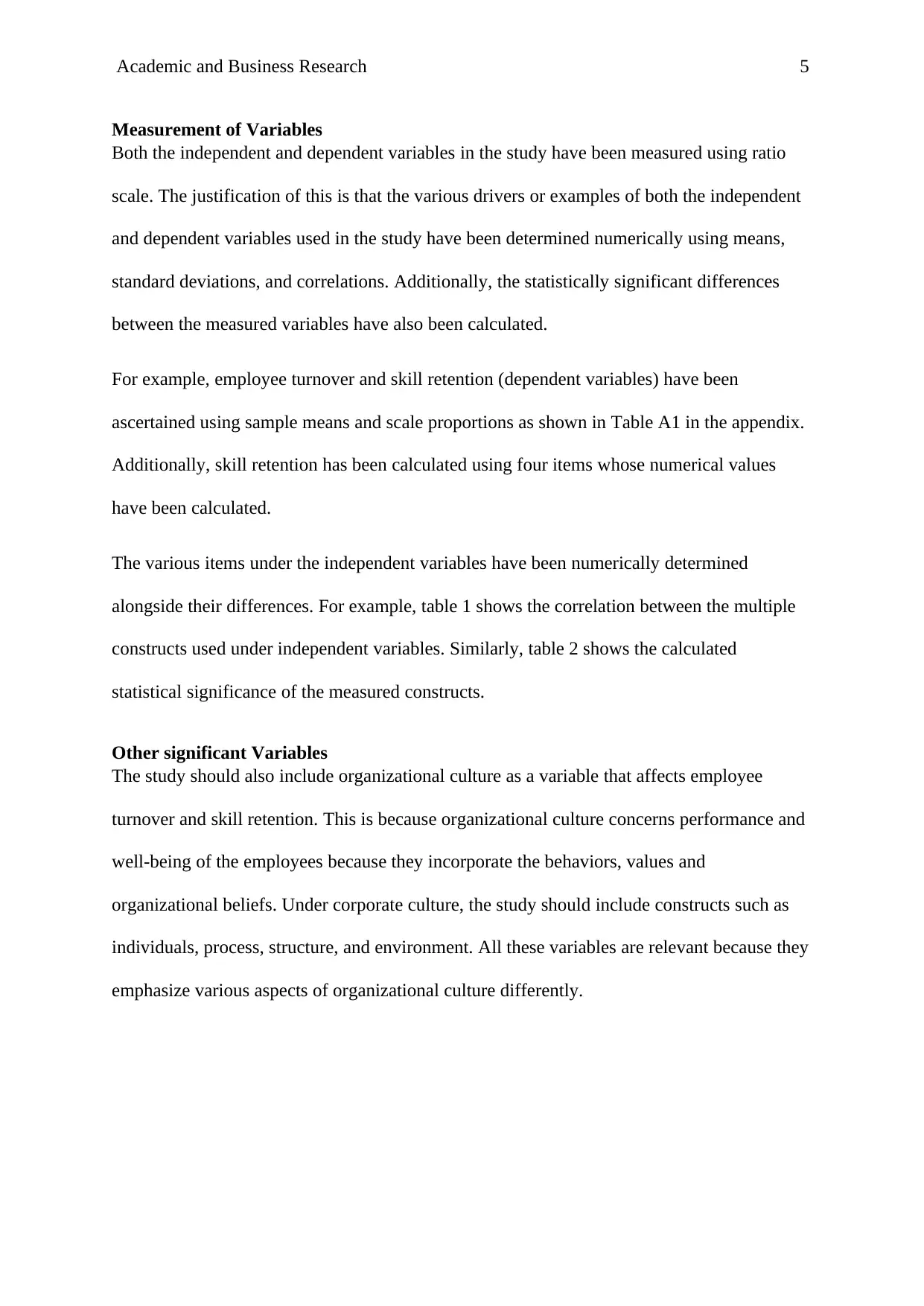
Academic and Business Research 5
Measurement of Variables
Both the independent and dependent variables in the study have been measured using ratio
scale. The justification of this is that the various drivers or examples of both the independent
and dependent variables used in the study have been determined numerically using means,
standard deviations, and correlations. Additionally, the statistically significant differences
between the measured variables have also been calculated.
For example, employee turnover and skill retention (dependent variables) have been
ascertained using sample means and scale proportions as shown in Table A1 in the appendix.
Additionally, skill retention has been calculated using four items whose numerical values
have been calculated.
The various items under the independent variables have been numerically determined
alongside their differences. For example, table 1 shows the correlation between the multiple
constructs used under independent variables. Similarly, table 2 shows the calculated
statistical significance of the measured constructs.
Other significant Variables
The study should also include organizational culture as a variable that affects employee
turnover and skill retention. This is because organizational culture concerns performance and
well-being of the employees because they incorporate the behaviors, values and
organizational beliefs. Under corporate culture, the study should include constructs such as
individuals, process, structure, and environment. All these variables are relevant because they
emphasize various aspects of organizational culture differently.
Measurement of Variables
Both the independent and dependent variables in the study have been measured using ratio
scale. The justification of this is that the various drivers or examples of both the independent
and dependent variables used in the study have been determined numerically using means,
standard deviations, and correlations. Additionally, the statistically significant differences
between the measured variables have also been calculated.
For example, employee turnover and skill retention (dependent variables) have been
ascertained using sample means and scale proportions as shown in Table A1 in the appendix.
Additionally, skill retention has been calculated using four items whose numerical values
have been calculated.
The various items under the independent variables have been numerically determined
alongside their differences. For example, table 1 shows the correlation between the multiple
constructs used under independent variables. Similarly, table 2 shows the calculated
statistical significance of the measured constructs.
Other significant Variables
The study should also include organizational culture as a variable that affects employee
turnover and skill retention. This is because organizational culture concerns performance and
well-being of the employees because they incorporate the behaviors, values and
organizational beliefs. Under corporate culture, the study should include constructs such as
individuals, process, structure, and environment. All these variables are relevant because they
emphasize various aspects of organizational culture differently.
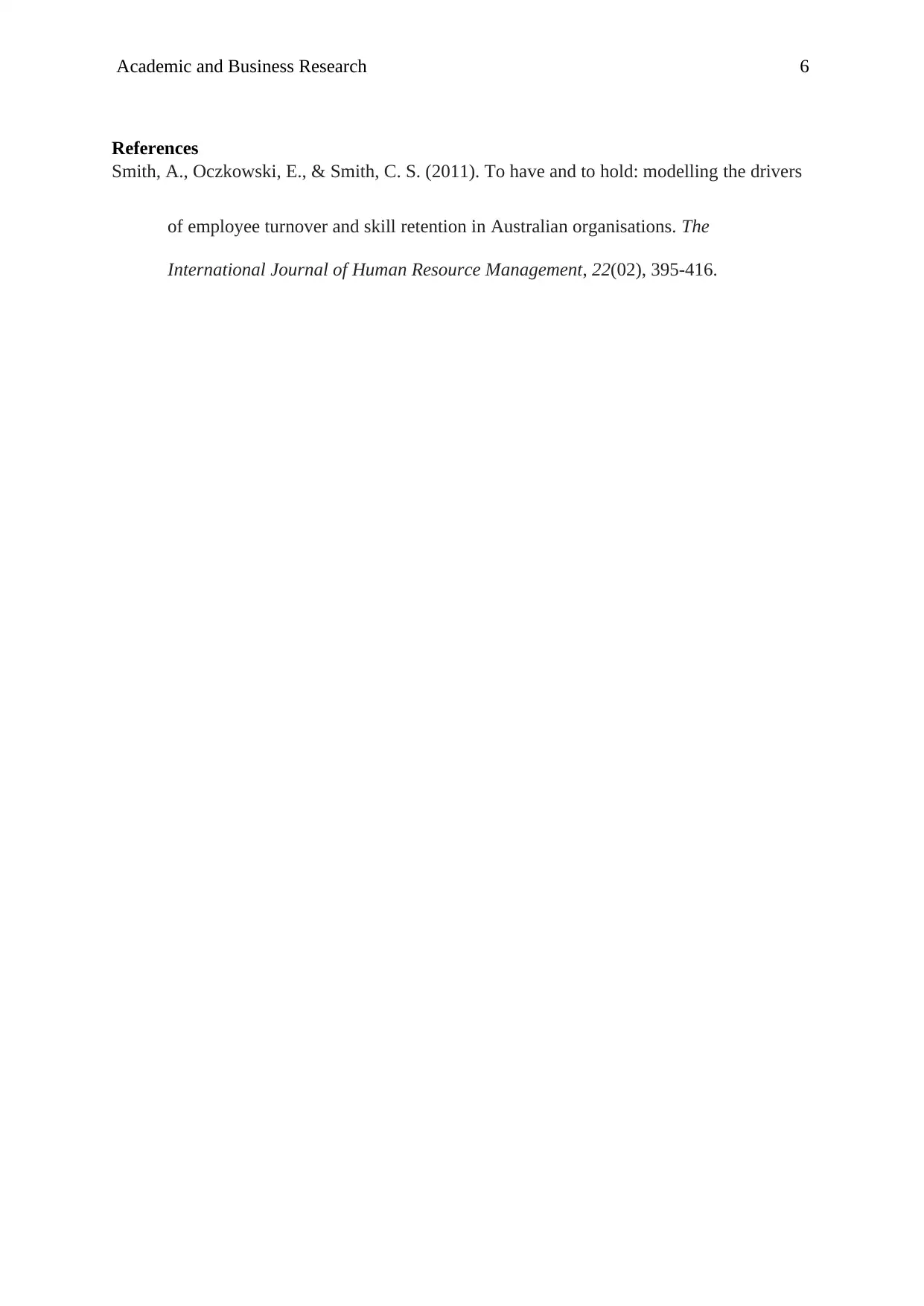
Academic and Business Research 6
References
Smith, A., Oczkowski, E., & Smith, C. S. (2011). To have and to hold: modelling the drivers
of employee turnover and skill retention in Australian organisations. The
International Journal of Human Resource Management, 22(02), 395-416.
References
Smith, A., Oczkowski, E., & Smith, C. S. (2011). To have and to hold: modelling the drivers
of employee turnover and skill retention in Australian organisations. The
International Journal of Human Resource Management, 22(02), 395-416.
⊘ This is a preview!⊘
Do you want full access?
Subscribe today to unlock all pages.

Trusted by 1+ million students worldwide
1 out of 6
Related Documents
Your All-in-One AI-Powered Toolkit for Academic Success.
+13062052269
info@desklib.com
Available 24*7 on WhatsApp / Email
![[object Object]](/_next/static/media/star-bottom.7253800d.svg)
Unlock your academic potential
Copyright © 2020–2025 A2Z Services. All Rights Reserved. Developed and managed by ZUCOL.




